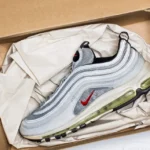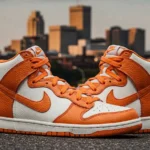Imagine a sneaker that was born to solve a problem on basketball courts but ended up conquering the streets, hip hop, and even celebrity wardrobes. This is the nike Air Force One, a shoe that has transcended generations and styles for over 40 years. Launched in 1982, it is not just one of the best-selling sneakers in Nike’s history; it is a true living legend of pop culture. Want to know how this icon went from sports to becoming a symbol of authenticity and versatility? Then grab a coffee, relax, and join me on this journey through time!
In this article, we will explore the origins of the Air Force One, its ups and downs, and how it transformed into a global object of desire. We will discuss the revolutionary design, historic partnerships, and even the moments when it almost disappeared, only to return stronger. If you are a sneaker fan or simply curious about how a simple shoe can make history, this text is for you.
The Origin: A Shoe Made for the Game
It all started in 1982 when Nike decided it was time to make a leap in the basketball market. Until then, the brand had already made noise with Air technology in running models like the Nike Air Tailwind of 1978. But basketball? That was new and challenging territory. Enter Bruce Kilgore, a designer tasked with creating something to protect the feet of NBA players, who at the time were suffering from the brutal impact of games, improvising with multiple layers of socks to cushion their jumps.
The result was the Nike Air Force One, named after the US presidential airplane, a name that already suggested greatness. It arrived with a high midsole and Air technology, using air chambers to absorb impact. The design was simple but functional: premium leather, high-top with ankle support, and a sole with a circular pattern that aided quick movements. It was the perfect shoe for the courts, but no one imagined it would go far beyond them.
(IMAGE: Bruce Kilgore holding the first prototype of the Air Force One, showcasing the innovative design of the time)
The Launch and Early Steps
The Air Force One was not an instant success. When it debuted, Nike knew it needed a strategy to convince the public, and the players, that this robust shoe was worth the investment. The solution? Calling the “Original Six,” a group of NBA stars that included names like Moses Malone and Michael Cooper. These guys were photographed in an iconic campaign, posing in a hangar as if they were pilots of the so-called “Air Force One.” The message was clear: this shoe was going to take your game to another level.
And it worked. Players started adopting the model, and fans soon realized there was something special about it. The Air cushioning was a differential, but the clean look, with the discreet Swoosh on the sides, also caught the eye. In 1983, Nike launched the low-top version, opening the door to an even larger audience. But it wasn’t all smooth sailing: in 1984, the brand decided to discontinue the Air Force One to focus on new projects. It seemed like the end of the line until the fans stepped in.
The Resurrection in Baltimore: The Power of Fans
If the Air Force One is what it is today, thank Baltimore. When Nike announced it was ending production, three local stores, Charley Rudo Sports, Cinderella Shoes, and Downtown Locker Room, refused to let the shoe die. They convinced the brand to continue supplying exclusive pairs to the city, creating the “Color of the Month Club.” Each month brought a new color, and sneakerheads from the East Coast made pilgrimages to secure their pairs.
This movement not only saved the Air Force One but also planted the seeds of the collector culture we see today. Nike realized its mistake and, in 1986, brought the model back on a global scale, now with a more modern logo. That’s when it started hitting the streets, especially in new york, where the Harlem neighborhood nicknamed it “Uptowns,” a sign that the shoe was leaving the courts behind.
(IMAGE: A store window in Baltimore displaying colorful pairs of the Air Force One in the 80s)
From Sports to Hip Hop: The Cultural Turn
If the 80s were about basketball, the 90s were about style. The Air Force One found a new home in hip hop culture, especially with the launch of the “white on white,” the classic all-white that became a craze. Artists like Jay Z, Nelly, and Fat Joe not only wore the shoe but turned it into a status symbol. In 2002, Nelly released the song “Air Force Ones,” which exploded on the charts and put the sneaker on the radar of millions.
Hip hop embraced the Air Force One for its simplicity and versatility. It matched everything from baggy jeans to oversized t-shirts and represented authenticity. In Harlem, keeping your “Uptowns” impeccably white was almost a matter of honor. This bond with music and urban fashion was essential in cementing the shoe’s status as a cultural icon, something even Nike could not have predicted.
Design Evolution: Tradition and Innovation
The Air Force One never stopped reinventing itself. From the original high-top model, it gained mid-top, low-top versions, and even special editions with details like velcro straps or platform soles. Air technology continued to be the heart of the shoe, but premium leather and customization options like NikeiD, launched in the 2000s, kept the model updated.
A milestone came in 2017, with the 35th anniversary of the Air Force One. Nike called on names like Virgil Abloh and Travis Scott to create limited editions, such as the AF 100 collection. These designs not only celebrated the shoe’s legacy but elevated it to a new level of hype. More recently, collaborations with brands like Louis Vuitton and Tiffany & Co. showed that the Air Force One can be both streetwear and high fashion.
(IMAGE: A pair of Nike Air Force One AF 100, with exclusive details by Virgil Abloh)
Global Impact: A Shoe Without Borders
Today, the Air Force One is a global phenomenon. It is sold in over 1,700 color variations and has generated billions in revenue for Nike. From Japan, where exclusive editions like the “Linen” of 2001 became legendary, to the US, where it still reigns in streetwear, the shoe has crossed cultures and continents. Celebrities like Rihanna, Kendrick Lamar, and even Hailey Bieber are seen with their pairs, proving that the appeal of the Air Force One is universal.

History of the Air Max 97, a Classic That Blends Innovative Technology, Striking Design, and a Story Full of Layers

Air Jordan 1 – The Story of the Sneaker That Defied the Rules and Became a Legend

The Journey of the Nike Dunk: A Timeless Story of Courts, Streets, and Culture

All about Nike’s collaboration with Off-White

Sneakerhead Dictionary: Essential Words, Slang, and Acronyms of Sneaker Culture
But what explains this success? Part of it is nostalgia; those who grew up in the 90s or 2000s have an emotional connection to the shoe. Part of it is the timeless design, which works both on a skateboard and at a casual dinner. And, of course, Nike knew how to keep the model relevant with strategic releases and sharp marketing. According to Nike, the Air Force One remains its best-selling shoe of all time.
Curiosities You Need to Know
Did you know that the Air Force One almost became a hiking boot? Bruce Kilgore was inspired by hiking boots for the original design, which explains the robust ankle support. Another curiosity: in 2007, for the 25th anniversary, Nike released luxury editions made in Italy, with crocodile leather and gold details, costing up to $2,000. These details show how the shoe has always been one step ahead.
And there’s more: the nickname “Uptowns” is not official, but it caught on so much that even Nike has used the term in campaigns. And that medallion on the laces? It’s removable, but many people don’t know that. Little stories that make the Air Force One even more fascinating.
Conclusion: Why the Air Force One Still Captivates Us
Looking back, it’s clear that the Nike Air Force One is more than just a shoe; it’s a piece of history. It started as a practical solution for athletes but transformed into a symbol of identity, creativity, and resilience. Those of us who have followed this journey see in it a reflection of how culture can turn simple objects into eternal icons. Whether for its design, nostalgia, or cultural impact, the Air Force One remains strong, proving that a good classic never goes out of style.
FAQ: Frequently Asked Questions About the Nike Air Force One
When was the Nike Air Force One launched?
The Nike Air Force One was launched in 1982 as a basketball shoe designed by Bruce Kilgore.
Why is it called Air Force One?
The name is a tribute to the US presidential airplane, suggesting strength and prestige.
What is the Air technology in the Air Force One?
It is a cushioning system with air chambers in the midsole, created to absorb impact.
What was the first color of the Air Force One?
The original model was white with gray neutral details, a clean and functional look.
Who saved the Air Force One from extinction?
Stores in Baltimore, such as Charley Rudo Sports, pressured Nike to continue production in 1984.
What is the most popular version of the Air Force One?
The “white on white” low-top is considered the most iconic and best-selling.
What are the most famous collaborations?
Notable partnerships include those with Virgil Abloh, Travis Scott, Louis Vuitton, and Tiffany & Co.
Why is it called “Uptowns”?
The nickname originated in Harlem, New York, where the shoe became a sensation in urban fashion.
How many colors has the Air Force One had?
Over 1,700 color variations have been released since 1982.
Is the Air Force One still relevant today?
Yes, it remains one of Nike’s best-selling shoes and a global streetwear icon.

History of the Air Max 97, a Classic That Blends Innovative Technology, Striking Design, and a Story Full of Layers

Air Jordan 1 – The Story of the Sneaker That Defied the Rules and Became a Legend

The Journey of the Nike Dunk: A Timeless Story of Courts, Streets, and Culture

All about Nike’s collaboration with Off-White


